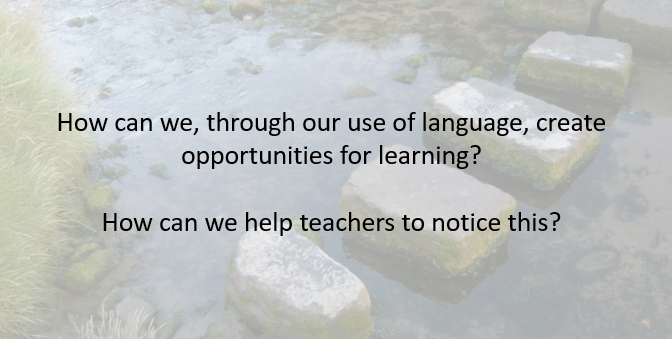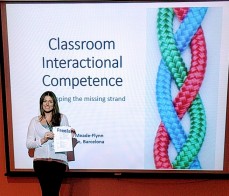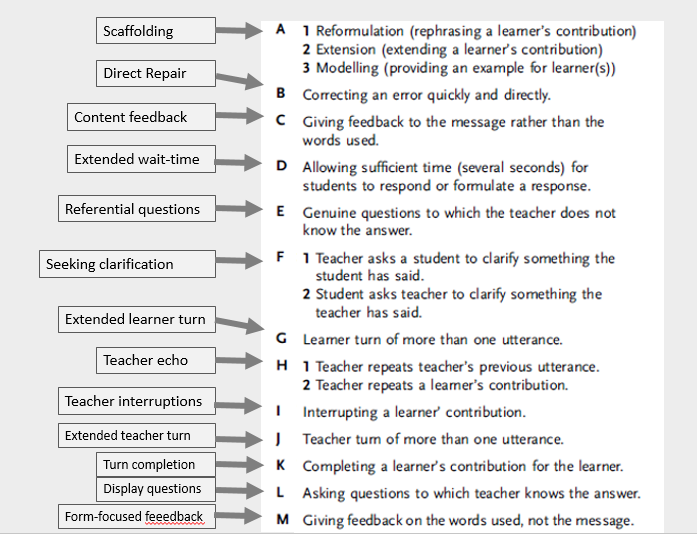Classroom Interactional Competence: Developing the Missing Strand
Notes from a talk given at IATEFL 2017 on teacher talk and interaction in the second language classroom.

If you’ve ever been observed teaching, or if you’re training teachers, you’re probably familiar with the initialism T.T.T. – and we’re not talking test-teach-test. Not just now anyway. We’re talking about Teacher Talk Time.
T.T.T. is often seen as taboo. You’ve probably been told that yours is too high at some stage in your career. I know I have. If you’re a trainer you’ve probably told teachers that theirs is too high too. I’ve definitely done this too. And I still do.
We all need to cut down and hand over to the students.
Reduce your TTT. Script your instructions. Your TTT is too high. Stop lecturing the students. Stop echoing. Stop having a running commentary on your lesson.
Don’t get me wrong – I don’t disagree with the above advice – I think students do need to take control and that teachers often do talk too much.
But in focussing on the time or amount rather than the quality of teacher talk and student talk, I think we’re missing the point. I say ‘I’ think we’re missing the point, but as ever these are not new ideas. Scroll through the slides below to the references and you’ll see that many people have flagged this issue up before. One key figure informing the field would be Steve Walsh, who has researched and indeed come up with practical routes out of this cul-de-sac of focussing merely on the amount of talk happening in the classroom. Instead of focussing on the amount of talk, we should focus on whether this talk matches our intentions at any given stage of a lesson.
And what are our intentions? Surely our main goal in the classroom should be to maximise learning opportunities. Teacher – student interaction in the classroom is one ripe area for such opportunities. So one of our goals should be that:
- we as teachers, and
- our students
are interactively competent in the classroom. This is what Steve Walsh calls Classroom Interactive Competence.

How to develop this in our own practice, but especially how to strengthen this ‘missing strand’ in teacher education was the principal focus of the talk.

In the talk we  looked at the development of CIC as distinct from Interactive Competence – with the classroom being a very specific context that demands its own interaction patterns. I shared my own initial attempts to integrate an awareness of CIC at different levels of teacher development on initial and in-service ELT training courses: Trinity Cert. and Dip. TESOL and Cambridge CELTA and Delta.
looked at the development of CIC as distinct from Interactive Competence – with the classroom being a very specific context that demands its own interaction patterns. I shared my own initial attempts to integrate an awareness of CIC at different levels of teacher development on initial and in-service ELT training courses: Trinity Cert. and Dip. TESOL and Cambridge CELTA and Delta.
This was realised by using transcribed extracts of recorded lessons and self-evaluation tasks, together with assignments which integrated components of CIC in their design.
Critical to the whole discussion of TTT is having the right vocabulary to be able to identify what our talk is doing. Terminology on the slide below again comes from Walsh (2006).

Transcribing sections of our own classroom discourse and coding it using the above terminology allows us to notice patterns in our interaction, language use and over-use and see the effect that our teacher talk actually has on learning. I’ve tried it myself and can share the feeling reported by teachers in a study by Thornbury back in 1996 – that I was ‘ploughing ahead’ and not always exploiting student talk to maximise learning opportunities. Encouraging other teachers and trainees to do so has the advantage of creating critical reflection at the level of self-image as teachers.
The slides below show some of the assignments I’ve used on various courses, as well as more details about the terminology and where it comes from.
I hope you agree it’s an area worth developing in training courses. And also as a tool for professional development at any stage of your career. Have you ever tried it out?
Select Bibliography
Ellis, R 1998 Discourse control and the acquisition rich classroom in W Renandya and G.M. Jacobs (eds). Learners and Language Learning Anthology series 39. Singapore S E A M O Regional Language Centre
Thornbury, 1996, Teachers research teacher talk, ELT-J, 50/4 October
Van Lier, 2000 From input to affordance : social interactive learning from an ecological perspective, in JP Landolf (ed) Socio-cultural Theory and Second Language Learning
Walsh, S 2002 Construction or obstruction: teacher talk and learner involvement in the EFL classroom Language Teaching Research 6/1: 3-23
Walsh, S 2006 Investigating classroom discourse, London: Routledge
Walsh, S 2006, Talking the talk of the TESOL classroom, ELT J 60/ 2 April
Walsh, S 2011 Exploring Classroom Discourse, London: Routledge


